CITROEN C4 PICASSO 2020 Owners Manual
Manufacturer: CITROEN, Model Year: 2020, Model line: C4 PICASSO, Model: CITROEN C4 PICASSO 2020Pages: 316, PDF Size: 10.36 MB
Page 121 of 316
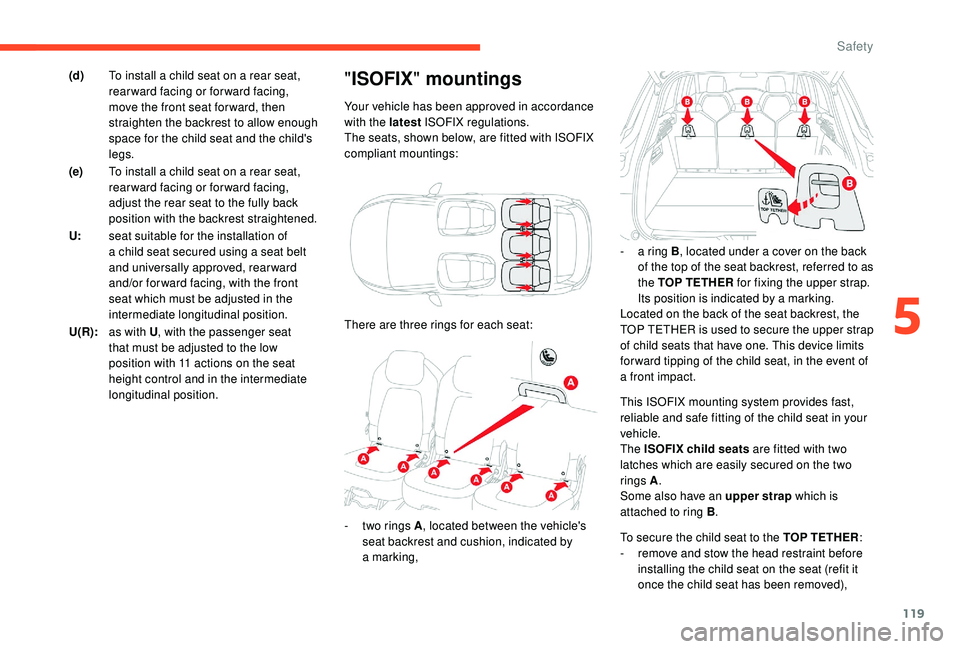
119
This ISOFIX mounting system provides fast,
reliable and safe fitting of the child seat in your
vehicle.
The ISOFIX child seats are fitted with two
latches which are easily secured on the two
rings A.
Some also have an upper strap which is
attached to ring B .
"ISOFIX " mountings
Your vehicle has been approved in accordance
with the latest ISOFIX regulations.
The seats, shown below, are fitted with ISOFIX
compliant mountings:
(d)
To install a
child seat on a
rear seat,
rearward facing or forward facing,
move the front seat for ward, then
straighten the backrest to allow enough
space for the child seat and the child's
legs.
(e) To install a
child seat on a
rear seat,
rearward facing or forward facing,
adjust the rear seat to the fully back
position with the backrest straightened.
U: seat suitable for the installation of
a
child seat secured using a
seat belt
and universally approved, rearward
and/or for ward facing, with the front
seat which must be adjusted in the
intermediate longitudinal position.
U(R): as with U , with the passenger seat
that must be adjusted to the low
position with 11
actions on the seat
height control and in the intermediate
longitudinal position. There are three rings for each seat:
-
t
wo rings A , located between the vehicle's
seat backrest and cushion, indicated by
a
marking, -
a r
ing B, located under a
cover on the back
of the top of the seat backrest, referred to as
the TOP TETHER for fixing the upper strap.
Its position is indicated by a
marking.
Located on the back of the seat backrest, the
TOP TETHER is used to secure the upper strap
of child seats that have one. This device limits
for ward tipping of the child seat, in the event of
a
front impact.
To secure the child seat to the TOP TETHER :
-
r
emove and stow the head restraint before
installing the child seat on the seat (refit it
once the child seat has been removed),
5
Safety
Page 122 of 316
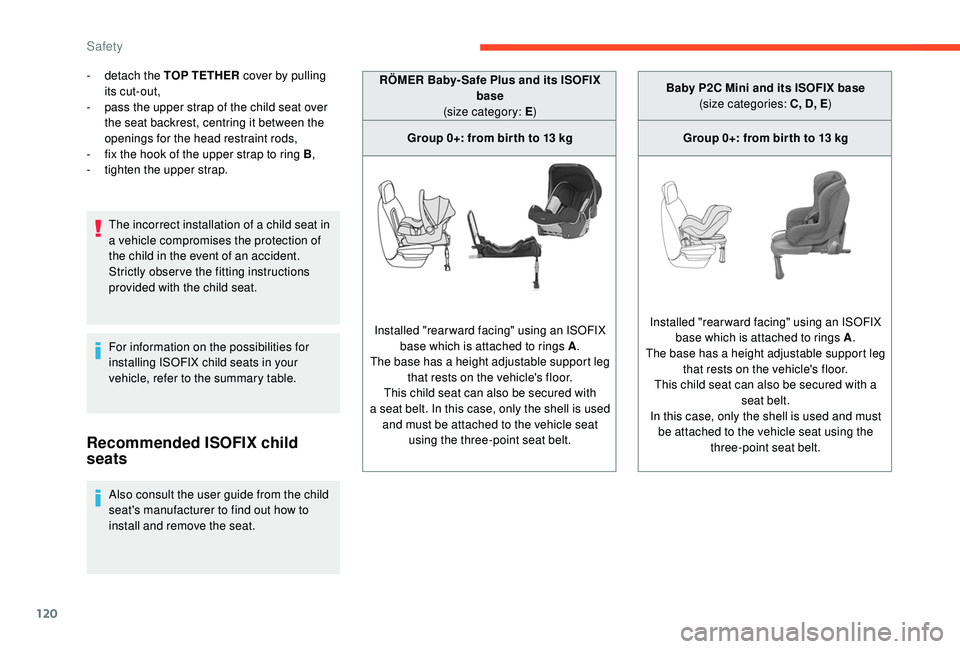
120
- detach the TOP TETHER cover by pulling its cut-out,
-
p
ass the upper strap of the child seat over
the seat backrest, centring it between the
openings for the head restraint rods,
-
f
ix the hook of the upper strap to ring B ,
-
t
ighten the upper strap.The incorrect installation of a
child seat in
a
vehicle compromises the protection of
the child in the event of an accident.
Strictly obser ve the fitting instructions
provided with the child seat.
For information on the possibilities for
installing ISOFIX child seats in your
vehicle, refer to the summary table.
Recommended ISOFIX child
seats
Also consult the user guide from the child
seat's manufacturer to find out how to
install and remove the seat. RÖMER Baby- Safe Plus and its ISOFIX
base
(size category: E )
Group 0+: from bir th to 13 kg
Installed "rearward facing" using an ISOFIX base which is attached to rings A .
The base has a height adjustable support leg
that rests on the vehicle's floor.
This child seat can also be secured with
a seat belt. In this case, only the shell is used
and must be attached to the vehicle seat using the three-point seat belt. Baby P2C Mini and its ISOFIX base
(size categories: C, D, E )
Group 0+: from bir th to 13 kg
Installed "rearward facing" using an ISOFIX base which is attached to rings A .
The base has a height adjustable support leg that rests on the vehicle's floor.
This child seat can also be secured with a seat belt.
In this case, only the shell is used and must be attached to the vehicle seat using the three-point seat belt.
Safety
Page 123 of 316

121
Baby P2C Midi and its ISOFIX base (size classes: D, C, A, B, B1 )
Group 1: from 9
to 18 kg
Installed "rearward facing" using an ISOFIX base which is attached to rings A .
The base has a height adjustable support leg that rests on the vehicle's floor.
This child seat can also be used "for ward fac ing".
This child seat cannot be secured with
a
seat belt.
We recommend that you use the seat in the "rear ward facing" position up to the age of 3
years.Summary tables of locations for
ISOFIX child seats
In line with European regulations, these tables
indicate the options for installing ISOFIX child
seats on the vehicle seats fitted with ISOFIX
mountings.
In the case of universal and semi-universal
ISOFIX child seats, the ISOFIX size category,
determined by a letter from A to G , is indicated
on the child seat next to the ISOFIX logo.
5
Safety
Page 124 of 316
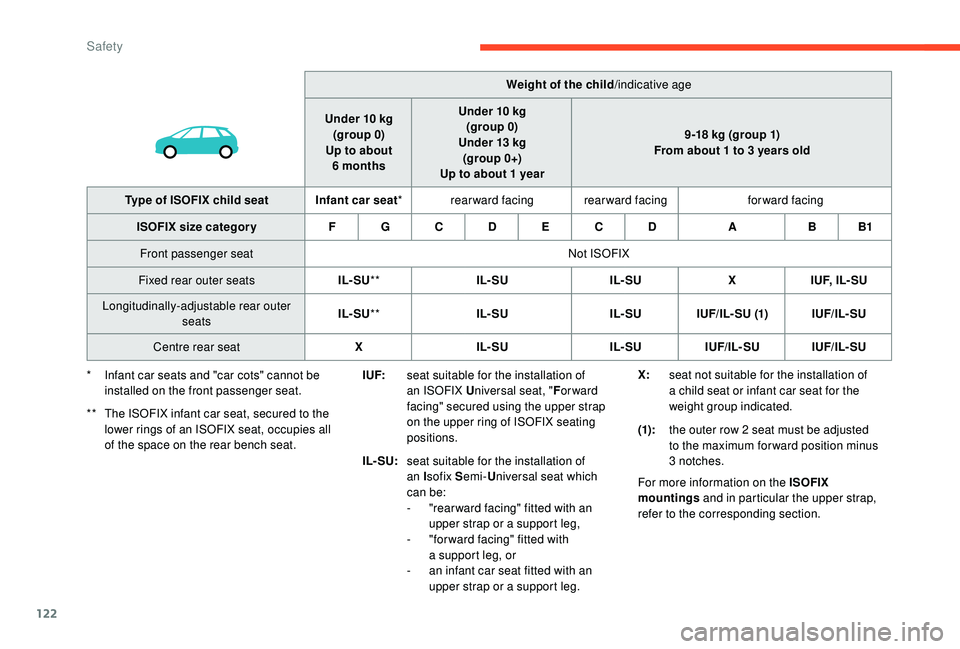
122
Weight of the child/indicative age
Under 10
kg
(group 0)
Up to about 6
months Under 10
kg
(group 0)
Under 13
kg
(group 0+)
Up to about 1
year 9-18
kg (group 1)
From about 1
to 3 years old
Type of ISOFIX child seat Infant car seat * rearward facing rearward facing forward facing
ISOFIX size categor y F G C D E C D ABB1
Front passenger seat Not ISOFIX
Fixed rear outer seats IL- SU** IL- SU IL- SUXI U F, I L - S U
Longitudinally-adjustable rear outer seats IL- SU
** IL- SU IL- SUI U F/ I L- SU (1) IUF/IL- SU
Centre rear seat XIL- SU IL- SUIUF/IL- SU IUF/IL- SU
*
I
nfant car seats and "car cots" cannot be
installed on the front passenger seat.
**
T
he ISOFIX infant car seat, secured to the
lower rings of an ISOFIX seat, occupies all
of the space on the rear bench seat. I UF:
seat suitable for the installation of
an ISOFIX U niversal seat, " For ward
facing" secured using the upper strap
on the upper ring of ISOFIX seating
positions.
IL- SU: seat suitable for the installation of
an Isofix S emi-Universal seat which
can be:
-
"
rear ward facing" fitted with an
upper strap or a
support leg,
-
"
for ward facing" fitted with
a
support leg, or
-
a
n infant car seat fitted with an
upper strap or a
support leg. X:
seat not suitable for the installation of
a
child seat or infant car seat for the
weight group indicated.
(1): the outer row 2
seat must be adjusted
to the maximum forward position minus
3
notches.
For more information on the ISOFIX
mountings and in particular the upper strap,
refer to the corresponding section.
Safety
Page 125 of 316
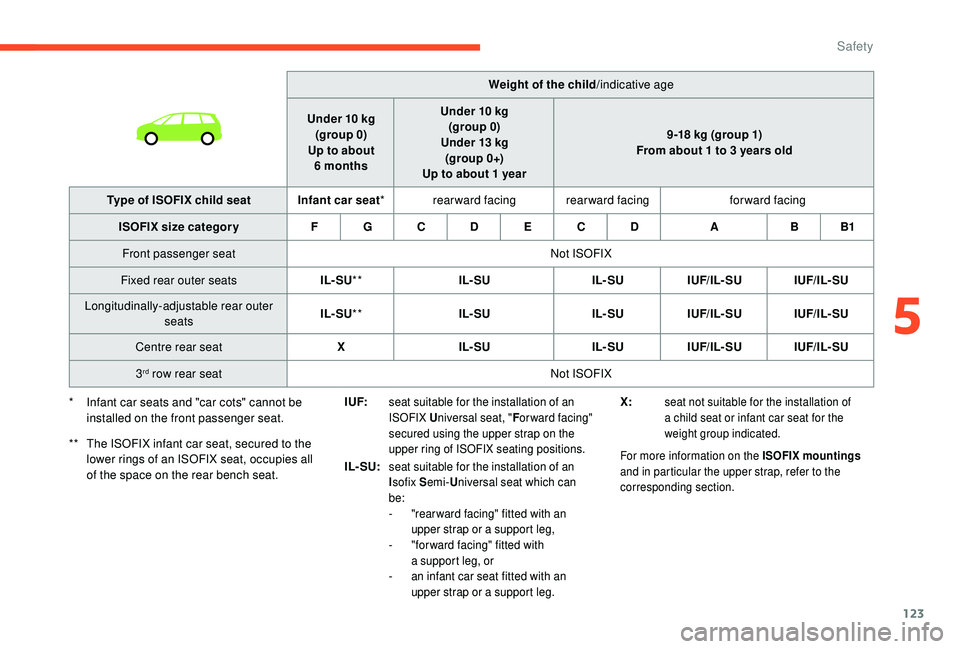
123
I UF:seat suitable for the installation of an
ISOFIX Universal seat, " For ward facing"
secured using the upper strap on the
upper ring of ISOFIX seating positions.
IL- SU:seat suitable for the installation of an
I sofix S emi-Universal seat which can
be:
-
"
rear ward facing" fitted with an
upper strap or a
support leg,
-
"
for ward facing" fitted with
a
support leg, or
-
a
n infant car seat fitted with an
upper strap or a
support leg.For more information on the ISOFIX mountings
and in particular the upper strap, refer to the
corresponding section.
Weight of the child /indicative age
Under 10
kg
(group 0)
Up to about 6
months Under 10
kg
(group 0)
Under 13
kg
(group 0+)
Up to about 1
year 9-18
kg (group 1)
From about 1
to 3 years old
Type of ISOFIX child seat Infant car seat * rearward facing rearward facing forward facing
ISOFIX size categor y F G C D E C D ABB1
Front passenger seat Not ISOFIX
Fixed rear outer seats IL- SU** IL- SU IL- SUIUF/IL- SU IUF/IL- SU
Longitudinally-adjustable rear outer seats IL- SU
** IL- SU IL- SUIUF/IL- SU IUF/IL- SU
Centre rear seat XIL- SU IL- SUIUF/IL- SU IUF/IL- SU
3
rd row rear seat Not ISOFIX
*
I
nfant car seats and "car cots" cannot be
installed on the front passenger seat.
**
T
he ISOFIX infant car seat, secured to the
lower rings of an ISOFIX seat, occupies all
of the space on the rear bench seat. X:
seat not suitable for the installation of
a
child seat or infant car seat for the
weight group indicated.
5
Safety
Page 126 of 316
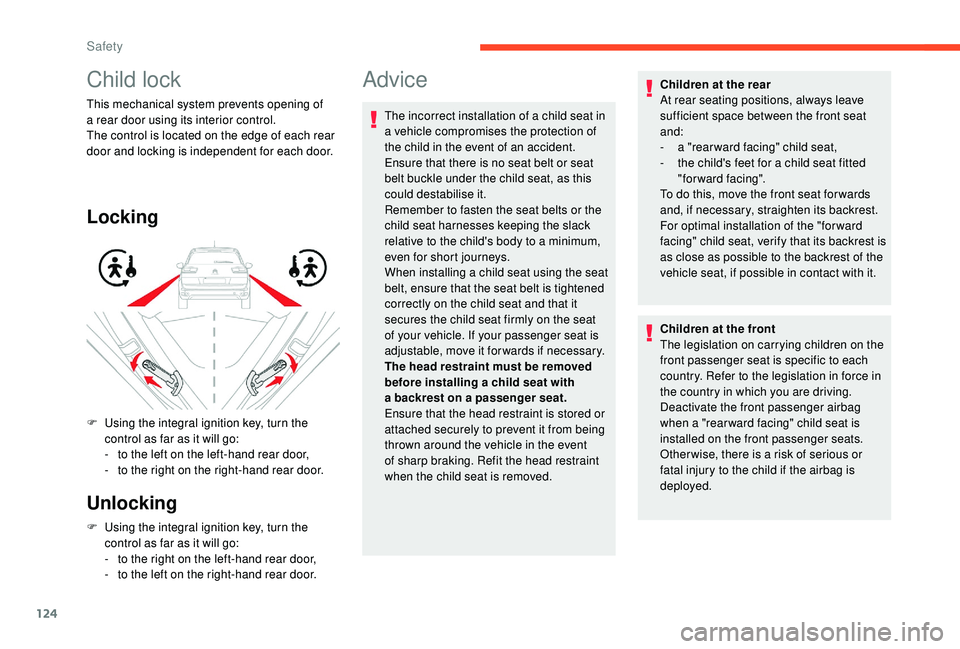
124
Child lock
This mechanical system prevents opening of
a rear door using its interior control.
The control is located on the edge of each rear
door and locking is independent for each door.
Locking
Unlocking
F Using the integral ignition key, turn the control as far as it will go:
-
t
o the right on the left-hand rear door,
-
t
o the left on the right-hand rear door.
F
U
sing the integral ignition key, turn the
control as far as it will go:
-
t
o the left on the left-hand rear door,
-
t
o the right on the right-hand rear door.
Advice
The incorrect installation of a child seat in
a vehicle compromises the protection of
the child in the event of an accident.
Ensure that there is no seat belt or seat
belt buckle under the child seat, as this
could destabilise it.
Remember to fasten the seat belts or the
child seat harnesses keeping the slack
relative to the child's body to a
minimum,
even for short journeys.
When installing a
child seat using the seat
belt, ensure that the seat belt is tightened
correctly on the child seat and that it
secures the child seat firmly on the seat
of your vehicle. If your passenger seat is
adjustable, move it forwards if necessary.
The head restraint must be removed
before installing a
child seat with
a
backrest on a passenger seat.
Ensure that the head restraint is stored or
attached securely to prevent it from being
thrown around the vehicle in the event
of sharp braking. Refit the head restraint
when the child seat is removed. Children at the rear
At rear seating positions, always leave
sufficient space between the front seat
and:
-
a "
rear ward facing" child seat,
-
t
he child's feet for a child seat fitted
"forward facing".
To do this, move the front seat for wards
and, if necessary, straighten its backrest.
For optimal installation of the "forward
facing" child seat, verify that its backrest is
as close as possible to the backrest of the
vehicle seat, if possible in contact with it.
Children at the front
The legislation on carrying children on the
front passenger seat is specific to each
country. Refer to the legislation in force in
the country in which you are driving.
Deactivate the front passenger airbag
when a "rear ward facing" child seat is
installed on the front passenger seats.
Other wise, there is a
risk of serious or
fatal injury to the child if the airbag is
deployed.
Safety
Page 127 of 316

125
Installing a booster seat
The chest part of the seat belt must be
positioned on the child's shoulder without
touching the neck.
Ensure that the lap part of the seat belt
passes correctly over the child's thighs.
We recommend using a
booster seat with
a
backrest, equipped with a belt guide at
shoulder level.
Additional protections
To prevent accidental opening of the doors
and rear windows, use the child lock.
Take care not to open the rear windows by
more than one third.
To protect young children from the rays
of the sun, fit side blinds on the rear
windows.
As a
safety precaution, do not leave:
-
a c
hild or children alone and
unattended in a
vehicle,
-
a c
hild or an animal in a vehicle
which is exposed to the sun, with the
windows closed,
-
t
he keys within reach of children inside
the vehicle.
5
Safety
Page 128 of 316

126
Driving advice
Observe driving regulations and remain vigilant
whatever the traffic conditions.
Pay close attention to the traffic and keep your
hands on the wheel so that you are ready to
react at any time to any eventuality.
As a safety measure, the driver should only
carry out any operations that require close
attention when the vehicle is stationary.
On a
long journey, taking a break every two
hours is strongly recommended.
In difficult weather, drive smoothly, anticipate
the need to brake and increase the distance
from other vehicles.
Never leave the engine running in
an enclosed area without adequate
ventilation: internal combustion engines
emit toxic exhaust gases, such as carbon
monoxide. There is a
risk of poisoning and
death!
In very severe wintry conditions
(temperatures below -23°C), to guarantee
correct operation and the longevity of
the mechanical elements of your vehicle
(engine and gearbox), the engine must be
left running for 4
minutes before driving.
Important!
Never drive with the parking brake applied
– Risk of overheating and damage to the
braking system!
As the exhaust system of your vehicle
is very hot, even several minutes after
switching off the engine, never park or run
the engine on inflammable sur faces (dry
grass, fallen leaves, etc.) – Risk of fire!
Never leave a vehicle unsuper vised with
the engine running. If you have to leave
your vehicle with the engine running, apply
the parking brake and put the gearbox into
neutral or position N or P , depending on
the type of gearbox.
Driving on flooded roads
We strongly advise against driving on flooded
roads, as this could cause serious damage
to the engine or gearbox, as well as to the
electrical systems of your vehicle. If you are obliged to drive on a
flooded road:
-
c
heck that the depth of water does not
exceed 15 cm, taking account of waves that
might be generated by other users,
-
d
eactivate the Stop & Start function,
-
d
rive as slowly as possible without stalling.
In all cases, do not exceed 6 mph (10 km/h),
-
d
o not stop and do not switch off the engine.
On leaving the flooded road, as soon as safety
conditions allow, make several light brake
applications to dry the brake discs and pads.
If in doubt on the state of your vehicle, contact
a CITROËN dealer or a qualified workshop.
Driving
Page 129 of 316

127
In case of towing
Driving with a trailer places greater
d emands on the towing vehicle and
requires extra care from the driver.
Side wind
F Take into account the increased sensitivity to wind.
Cooling
Towing a trailer on a slope increases the
t emperature of the coolant.
As the fan is electrically controlled, its cooling
capacity is not dependent on the engine speed.
F
T
o lower the engine speed, reduce your
speed.
The maximum towable load on an incline
depends on the gradient and the exterior
temperature.
In all cases, keep a
check on the coolant
temperature.
F
I
f this warning lamp and the
STOP warning lamp come on,
stop the vehicle and switch off
the engine as soon as possible.
New vehicle
Do not pull a trailer before having driven at least
approximately 620
miles (1,000
kilometres).
Braking
Towing a trailer increases the braking distance.
T o avoid overheating of the brakes, the use of
engine braking is recommended.
Ty r e s
F Check the tyre pressures of the towing vehicle and of the trailer, observing the
recommended pressures.
Lighting
F Check the electrical lighting and signalling on the trailer and the headlamp beam height
of your vehicle.
For more information on Headlamp
adjustment , refer to the corresponding
section.
Certain driving or manoeuvring aid
functions are automatically disabled if an
approved towing system is used.
Anti-theft protection
Electronic immobiliser
The keys contain an electronic chip which has
a secret code. When the ignition is switched
on, this code must be recognised in order for
starting to be possible.
This electronic engine immobiliser locks the
engine management system a
few moments
after the ignition is switched off, and prevents
starting of the engine by anyone who does not
have the key.
In the event of a
malfunction, you are informed
by a
message in the instrument panel screen.
If this happens, your vehicle will not start;
contact a
CITROËN dealer if required.
Starting/switching off
the engine using the
electronic key
Starting the engine
6
Driving
Page 130 of 316

128
F Place the gear selector at P or N for vehicles with an automatic gearbox or
neutral for vehicles with a
manual gearbox.
F
P
lace the electronic key in the reader.
F
P
ress the brake pedal for vehicles with an
automatic gearbox, or fully depress the
clutch pedal for vehicles with a
manual
gearbox.
F
B
riefly press the " START/STOP" button.
The steering column unlocks and the engine
starts more or less instantly.
On certain versions with the automatic gearbox
(EAT6/EAT8), the steering column does not
lock.
For Diesel vehicles , in sub-zero temperatures
the engine will not start until the pre-heater
warning lamp has gone off. If one of the starting conditions is not met,
a reminder message is displayed in the
instrument panel. In some circumstances, it is
necessary to turn the steering wheel slightly
while pressing the "START/STOP" button to
assist unlocking of the steering; a message
warns you when this is needed.
With petrol engines , after a
cold start,
preheating the catalytic converter can
cause noticeable engine vibrations for
anything up to 2
minutes while stationary
with the engine running (accelerated idle
speed).
If this warning lamp comes on after
pressing the "START/STOP" button,
press down on the brake or clutch
pedal until the warning lamp goes
off, without pressing the "START/
STOP" button again, until the engine
starts and runs.
Switching off the engine
F Immobilise the vehicle.
F P lace the gear selector at P or N for
vehicles with an automatic gearbox or
neutral for vehicles with a
manual gearbox.
F
P
ress the " START/STOP " button.
The engine stops and the steering column
locks.
On certain versions with the automatic gearbox
(EAT6/EAT8), the steering column does not
lock.
F
R
emove the electronic key from the reader. If the vehicle is not immobilised, the
engine will not stop.
Switching off the engine leads to a
loss of
braking assistance.
Emergency switch-off
In the event of an emergency only, the engine
can be switched off without conditions (even
when driving).
Press the " START/STOP " button for about
three seconds.
In this case, the steering column locks as soon
as the vehicle stops.
On certain versions with the automatic gearbox
(EAT6/EAT8), the steering column does not
lock.
Electronic key left in the reader
You will be warned by a
message if the
electronic key is still in the reader on
opening the driver's door.
Driving